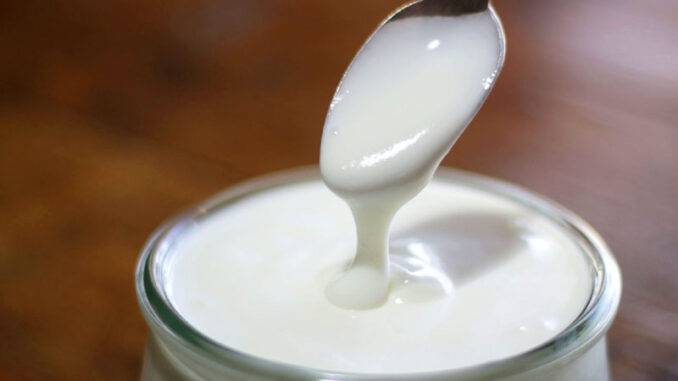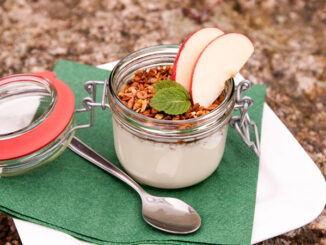
Since Kefir, buttermilk, and yogurt are all fermented dairy products, they often get mixed and confused. Some of our readers even ask us whether Kefir is a variety of yogurt or buttermilk.
Although Kefir, yogurt, and buttermilk are fermented milk products, their preparation, composition, probiotic content, and nutritional values are very different.
This article will dig deeper into these differences and clarify each of these products’ nutritional and probiotic values.
Buttermilk
Historically, buttermilk was the liquid that was left behind after churning butter out of the cream.
Years ago, the milk was usually left to sit until the cream and milk separated. During this period, natural processes of fermentation initiated in milk, and lactic acid-producing bacteria started coagulation and formation of curds. This natural fermentation was very welcome because it increased the shelf-life of milk and facilitated the butter churning process.
Today this “traditional style” buttermilk, left after churning butter, is rarely found in Western countries but is still a common beverage in India, Nepal, Pakistan, and some Arab countries.
Nowadays, commercially available buttermilk gets artificially inoculated with Lactococcus lactis or Lactobacillus bulgaricus to simulate the natural fermentation in the “traditional” product. In this way, today’s buttermilk (also called “cultured buttermilk”) is pretty similar to yogurt as it partially contains similar strains of probiotic bacteria as yogurt. Still, buttermilk is less dense than yogurt because of the higher whey content, much shorter fermentation period, and has far lower probiotic powers than yogurt.
Another type of buttermilk is the so-called “acidified buttermilk,” which is a substitute to real buttermilk made by adding an acid such as vinegar or lemon juice to milk until it curdles. This substitute to buttermilk has virtually no actual probiotic content and is mainly used for cooking.
Yogurt
Yogurt is already a full-featured product of milk’s bacterial fermentation. The main bacteria used to make yogurts are Lactobacillus bulgaricus and Streptococcus thermophilus, but the final product may contain a more extensive set of Lactobacilli and Bifidobacteria.
In all fermentation processes of milk, milk sugars (known as lactose) are converted by the probiotic bacteria into lactic acid. This process also affects milk protein giving the yogurt its texture and typical taste.
The most distinct aspect of yogurt is that the probiotic bacteria responsible for its fermentation are thermophilic, which means they thrive at relatively high temperatures. For this reason, temperature between 42° and 45°C (108° and 113°F) should be maintained for 8 to 12 hours for the yogurt to ferment fully.
There are several sub-type of yogurt, the most noticeable of which are Greek yogurt and Skyr.
Greek yogurt is thicker and is made by further straining regular yogurt to remove the liquid whey. The result is higher protein content, but the extra straining leads to lower calcium as most of the calcium is contained in the whey that gets drained out.
Like Greek yogurt, Skyr is an Icelandic variation of yogurt that is even denser, creamier, and richer in protein. Compared to regular yogurt, the preparation of Skyr requires four times the milk to make and contains about three times more protein.
All types and sub-types of yogurt are inoculated with at least two types of probiotic bacteria: Streptococcus thermophilus and Lactobacillus bulgaricus, but most types of commercially available yogurts in different parts of the world are known to contain up to 5-6 strains of probiotic bacteria, including Lactobacillus acidophilus, Lactobacillus amylovorous, Lactobacillus Brevis, Lactobacillus casei, and some strains of Bifidobacteria.
As we already said, the probiotic bacteria in yogurt are thermophilic, which means that they require higher temperatures (45°C / 113°F) to coagulate milk and fully convert it into yogurt. Because of the need for a constant and relatively high temperature, successful yogurt homemaking usually involves special appliances called “yogurt makers“.
As a result of its more numerous probiotic cultures and its more extended fermentation period, yogurt typically has a higher nutritional value and probiotic potency than buttermilk.
Difference between buttermilk and yogurt
Traditional buttermilk has been around for relatively longer than yogurt as a kind of “leftover” from churning butter out of the cream. Still, its probiotic and nutritional properties are considerably inferior to the ones of yogurt.
Even cultured buttermilk, which historically appeared later and is much richer in probiotics than traditional buttermilk, is still outperformed by yogurt in terms of probiotic content and nutritional values.
On the other hand, yogurt can be pretty called a full-featured probiotic dairy product.
With about 5 or 6 different probiotic microorganisms, mainly from the Streptococcus, Lactobacillus, and Bifidobacterium types, yogurt is considered a valuable probiotic addition to any health-conscious diet. It is an essential tool in the treatment of a series of gut-related disorders.
Kefir
And here comes the “heavy-weight” of all probiotic dairy products!
Just like yogurt and buttermilk, Kefir is also a fermented dairy drink, similar in look and taste to a slightly diluted yogurt. However, it is made with the help of Kefir grains, a specific type of symbiotic culture called SCOBY (standing for Symbiotic Culture Of Bacteria and Yeast).
The Kefir grains are creamy-white cauliflower-like formations that lie in the base of Kefir’s fermentation.

Two types of bacteria and yeast initially create the base of the Kefir grains: Lactobacillus kefiranofaciens and Saccharomyces turicensis, which surface then get adhered to by complex bacterial microcolony that also includes Lactobacillus acidophilus, Bifidobacterium bifidum, Streptococcus thermophilus, Lactobacillus bulgaricus, Lactobacillus helveticus, Lactobacillus kefiranofaciens, Lactococcus lactis, Leuconostoc species, and many others.
Although years ago yogurt was the best-known dairy probiotic food in the Western world, Kefir was found to be a drastically more potent source of probiotics. However, while Kefir finds its origins in ancient times, its spread to Western Europe and the United States started no earlier than the beginning of 21 century.
Kefir grains typically contain about 50 different probiotic bacteria and yeasts, but up to 63 of these strains have been discovered in some colonies around the globe. So, although the diversity of its bacterial content may vary, Kefir is undoubtedly the richest in probiotics and the most potent fermented dairy product in the world.
Besides containing considerably less lactose than natural milk, Kefir contains strains of yeasts that support and boost lactose metabolization. This fact makes it much better accepted by people affected by lactose intolerance.
The bacteria responsible for fermentation or Kefir are mesophilic, which means they thrive at average room temperatures. That is why the preparation of milk kefir is also the easiest way to get a healthy probiotic drink at home. Just mix the Kefir grains with fresh milk and leave them at room temperature for 12 to 24 hours.
Although kefir drink’s final content may vary depending on the specific culture used for the fermentation, Kefir is known to include about 50 different types of probiotic strains of bacteria that make its probiotic potency really unrivaled.
In addition to beneficial bacteria and yeast, Kefir also contains large amounts of minerals and essential amino acids that have beneficial effects on almost all body systems.
Indeed, the health benefits of Kefir are numerous, including helping with weight loss, fighting the consequences of aging, and many more.
Kefir also has a series of cosmetic benefits, and many specialists recommend it during pregnancy and breastfeeding.
As we already said, Kefir is also known to be better tolerated by people with lactose intolerance because the microorganisms of Kefir convert most of the lactose of milk (the milk sugars) into lactic acid, leaving relatively low levels of lactose in the final product.
Like any other nutritional product containing live microorganisms, however, we should approach the consumption of milk Kefir with certain precautions.
For instance, people with compromised immune systems or under immunosuppressive treatment should be extremely cautious when taking Kefir and always consult their physicians.
Difference between yogurt and Kefir
While yogurt may be considered a full-featured probiotic dairy product, Kefir is the unrivaled “heavy-weight” of all milk-based probiotic products.
Kefir contains up to 50 different probiotic bacteria and yeast strains known to affect many aspects of our health positively.
They include controlling blood sugar levels, lowering cholesterol levels and blood pressure, improving stomach health, controlling weight, and having various positive effects against gastroenteritis, IBS, SIBO, vaginal infections, yeast infections, and many other health-related conditions.
A significant advantage of Kefir is that its bacteria, unlike yogurt, tend to colonize the gastrointestinal tract and exercise their beneficial effect long after the intake of Kefir is stopped. This ability of Kefir’s bacteria to colonize the guts and stay there longer is one of the most valuable advantages of Kefir compared to yogurt and buttermilk.
Nutritional facts
| Nutritional value per 100 g. (3.5 oz) |
Cow’s whole milk | Buttermilk | Yogurt | Kefir |
| Energy | 265 kJ (64 kcal) | 169 kJ (40 kcal) | 333 kJ (79 kcal) | 262 kJ (63 kcal) |
| Carbohydrates | 4.6 g | 4.8 g | 3.8 g | 4.5 g |
| Fat | 3.6 g | 0.9 g | 5.0 g | 3.5 g |
| Protein | 3.4 g | 3.3 g | 5.7 g | 3.3 g |
| Probiotic bacteria strains | ~ 0 | ~ 2 | ~ 5 | ~ 50 |
Summary
Years ago, buttermilk was the liquid that was left behind after churning butter out of the cream. The milk was often left to sit until it started to ferment, and cream milk separated from the milk, thus making churning easier. Today this “traditional style” buttermilk, left after churning butter, is rarely found in Western countries but is still a common beverage in the far East.
Buttermilk is the least rich in probiotics amongst all three fermented dairy products. Even cultured buttermilk, which is additionally inoculated with probiotic bacteria, is still outperformed by yogurt in terms of probiotic content and nutritional values.
Yogurt has considerably more probiotic bacteria than buttermilk and is already a full-featured probiotic product. The main bacteria used to inoculate yogurts are Lactobacillus bulgaricus and Streptococcus thermophilus. Some commercial varieties of yogurt often contain additionally added probiotic bacteria like Bifidobacteria.
The most distinctive aspect of yogurt is that the bacteria responsible for its fermentation are thermophilic, which means they need relatively high temperatures to coagulate milk. That is why temperature between 42° and 45°C (108° and 113°F) should be maintained for 8 to 12 hours for the preparation of yogurt. This fact often requires the use of special appliances called “yogurt makers“.
Kefir is by far the richest in probiotics fermented dairy product, also called “the heavy-weight of probiotics”. Kefir typically contains about 50 different types of probiotic bacteria and yeasts, while yogurt may have no more than 5 or 6 probiotic bacterial strains and buttermilk – about 1 or 2.
Along with the myriad of beneficial probiotic bacteria, Kefir also contains large amounts of minerals and amino acids that have beneficial effects on almost all body systems, including helping with weight loss, fighting the consequences of aging, and also has a series of cosmetic benefits. Consumption of Kefir is recommended even during pregnancy and breastfeeding.
As an additional benefit, the probiotic bacteria of Kefir are mesophilic, which means that they coagulate milk at regular room temperatures. As a result, the preparation of milk Kefir at home is straightforward, easy, and doesn’t require the use of any special appliances.
Related questions
- Do buttermilk, yogurt, and Kefir have any contraindications? All three fermented dairy products contain living microorganisms, and some people should approach their consumption with the needed precautions. People with a compromised immune system or under immunosuppressive medications should be especially cautious. However, outside of this reminder, buttermilk, yogurt, and Kefir have virtually no other contraindications and can freely be consumed by anyone, including children, pregnant women, breastfeeding mothers, and older people.
- Can any of these fermented products go bad? Yes and no! Excessively long fermentation may cause all of these three dairy products to over-ferment, resulting in a very tangy and acidic taste that some people may dislike. However, even over-fermented buttermilk, yogurt, or Kefir are unlikely to do any harm because over-refermentation only increases their probiotic powers.
Related resources
- What is Kefir?
- Kefir benefits
- What are probiotics?
- What are microbiome and microbiota?
- Kefir pros and cons
- Three easy tricks for a better Kefir
- Is Kefir lactose-free?
- Is Kefir gluten-free?
- Is Kefir vegan?
- Common myths about milk kefir
- Most frequently asked questions about Kefir
- Kefir vs. Yogurt. What are the differences?



